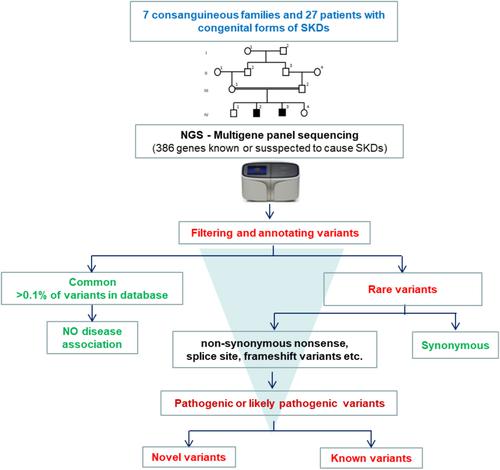当前位置:
X-MOL 学术
›
Clin. Genet.
›
论文详情
Our official English website, www.x-mol.net, welcomes your feedback! (Note: you will need to create a separate account there.)
Multi‐gene panel sequencing in highly consanguineous families and patients with congenital forms of skeletal dysplasias
Clinical Genetics ( IF 3.5 ) Pub Date : 2024-02-20 , DOI: 10.1111/cge.14509 Naseebullah Kakar 1, 2, 3 , Fazal ur Rehman 4 , Ramandeep Kaur 5 , Gandham SriLakshmi Bhavani 6 , Manisha Goyal 7 , Hitesh Shah 8 , Karandeep Kaur 5 , Kushaljit Singh Sodhi 9 , Christian Kubisch 10 , Guntram Borck 3 , Inusha Panigrahi 5 , Katta Mohan Girisha 6 , Uwe Kornak 11 , Malte Spielmann 1
Sk eletal d ysplasias (SKDs) are a heterogeneous group of more than 750 genetic disorders characterized by abnormal development, growth, and maintenance of bones or cartilage in the human skeleton. SKDs are often caused by variants in early patterning genes and in many cases part of multiple malformation syndromes and occur in combination with non‐skeletal phenotypes. The aim of this study was to investigate the underlying genetic cause of congenital SKDs in highly consanguineous Pakistani families, as well as in sporadic and familial SKD cases from India using multigene panel sequencing analysis. Therefore, we performed panel sequencing of 386 bone‐related genes in 7 highly consanguineous families from Pakistan and 27 cases from India affected with SKDs. In the highly consanguineous families, we were able to identify the underlying genetic cause in five out of seven families, resulting in a diagnostic yield of 71%. Whereas, in the sporadic and familial SKD cases, we identified 12 causative variants, corresponding to a diagnostic yield of 44%. The genetic heterogeneity in our cohorts was very high and we were able to detect various types of variants, including missense, nonsense, and frameshift variants, across multiple genes known to cause different types of SKDs. In conclusion, panel sequencing proved to be a highly effective way to decipher the genetic basis of SKDs in highly consanguineous families as well as sporadic and or familial cases from South Asia. Furthermore, our findings expand the allelic spectrum of skeletal dysplasias.
中文翻译:

高度近亲家庭和先天性骨骼发育不良患者的多基因组测序
斯克 埃埃塔尔d 发育异常 (SKD) 是由 750 多种遗传性疾病组成的异质性群体,其特征是人体骨骼中骨骼或软骨的发育、生长和维持异常。SKD 通常是由早期模式基因变异引起的,在许多情况下是多种畸形综合征的一部分,并与非骨骼表型结合发生。本研究的目的是利用多基因组测序分析,调查高度近亲巴基斯坦家庭以及印度散发和家族性 SKD 病例中先天性 SKD 病例的潜在遗传原因。因此,我们对来自巴基斯坦的 7 个高度近亲家庭和来自印度的 27 个 SKD 患者的 386 个骨骼相关基因进行了面板测序。在高度近亲的家庭中,我们能够在七个家庭中的五个中识别出潜在的遗传原因,诊断率为 71%。而在散发性和家族性 SKD 病例中,我们确定了 12 个致病变异,对应的诊断率为 44%。我们队列中的遗传异质性非常高,我们能够在已知导致不同类型 SKD 的多个基因中检测到各种类型的变异,包括错义、无义和移码变异。总之,组合测序被证明是破译高度近亲家庭以及南亚散发和/或家族病例中 SKD 遗传基础的高效方法。此外,我们的研究结果扩大了骨骼发育不良的等位基因谱。
更新日期:2024-02-20
Clinical Genetics ( IF 3.5 ) Pub Date : 2024-02-20 , DOI: 10.1111/cge.14509 Naseebullah Kakar 1, 2, 3 , Fazal ur Rehman 4 , Ramandeep Kaur 5 , Gandham SriLakshmi Bhavani 6 , Manisha Goyal 7 , Hitesh Shah 8 , Karandeep Kaur 5 , Kushaljit Singh Sodhi 9 , Christian Kubisch 10 , Guntram Borck 3 , Inusha Panigrahi 5 , Katta Mohan Girisha 6 , Uwe Kornak 11 , Malte Spielmann 1
Affiliation

|
中文翻译:

高度近亲家庭和先天性骨骼发育不良患者的多基因组测序



























 京公网安备 11010802027423号
京公网安备 11010802027423号